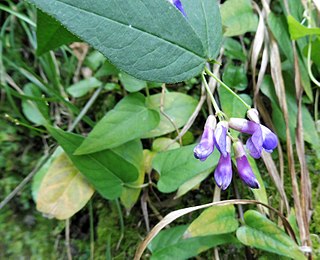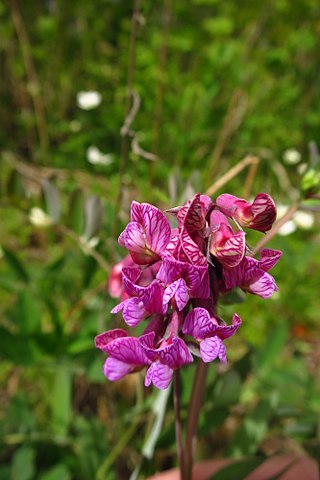
Ydre Municipality is a municipality in Östergötland County, southeast Sweden. The municipal seat is located in the town of Österbymo.

Vicia sativa, known as the common vetch, garden vetch, tare or simply vetch, is a nitrogen-fixing leguminous plant in the family Fabaceae. It is now naturalised throughout the world occurring on every continent, except Antarctica and the Arctic. The centre of diversity is thought to be the Fertile Crescent, although gold standard molecular confirmation is currently not available.

Vicia is a genus of over 240 species of flowering plants that are part of the legume family (Fabaceae), and which are commonly known as vetches. Member species are native to Europe, North America, South America, Asia and Africa. Some other genera of their subfamily Faboideae also have names containing "vetch", for example the vetchlings (Lathyrus) or the milk-vetches (Astragalus). The lentils are included in genus Vicia, and were formerly classified in genus Lens. The broad bean is sometimes separated in a monotypic genus Faba; although not often used today, it is of historical importance in plant taxonomy as the namesake of the order Fabales, the Fabaceae and the Faboideae. The tribe Vicieae in which the vetches are placed is named after the genus' current name. The true peas (Pisum) are among the closest living relatives of vetches.

Vicia villosa, known as the hairy vetch, fodder vetch or winter vetch, is a plant native to some of Europe and western Asia. It is a legume, grown as a forage crop, fodder crop, cover crop, and green manure. Although non-native, it occurs in all US states and is considered invasive by some states, such as Alaska, Florida, Georgia, Kansas, Michigan, Minnesota, Nebraska, Oregon, and Washington state — as well as in Japan and some parts of Europe where it is not native. It is also found in most Canadian provinces.

Vicia americana is a species of legume in the vetch genus known by the common names American vetch and purple vetch. It includes a subspecies known as mat vetch.

Cosmopterix schmidiella is a moth of the family Cosmopterigidae. It is found from most of Great Britain to Romania, and from Japan through central Russia to the Iberian Peninsula. It is believed to be extinct in Britain.
Xystophora carchariella is a moth of the family Gelechiidae. It is found from southern and central Europe to the Ural Mountains, Sweden and the Baltic States. Outside of Europe, it is also found in Turkey, China and the Russian Far East.

Vicia unijuga, commonly called two-leaf vetch, is a species of flowering plant in the legume family.

Vicia cassubica, called Kashubian vetch and Danzig vetch, is a species of flowering plant in the genus Vicia, native to most of Europe, Turkey, the Levant, the Caucasus and Iran. Found in thermophilous oak forests, it also does well in old fields that are in later stages of succession.

Lathyrus pisiformis is a species of flowering plant belonging to the family Fabaceae.

Vicia biennis is a species of flowering plant belonging to the family Fabaceae.

Vicia ludoviciana, also known by its common name slender vetch is a species from the genus Vicia.

†Vicia dennesiana is a species in the Fabaceae family, named after the solicitor and plant collector George Edgar Dennes. It is protected by the Bern Convention on the Conservation of European Wildlife and Natural Habitats. This species has not been found in the wild since 1848, and is considered extinct in its natural habitat. It has not been observed in cultivation since 1922.

Vicia narbonensis, called Narbon bean, Narbon vetch, Narbonne vetch and moor's pea, is a widely distributed species of flowering plant in the family Fabaceae. It is native to Madeira and the Mediterranean countries through to Central Asia and the western Himalayas, and has been introduced to central and eastern Europe, and scattered other locations. It has some palatability issues, but has potential as a green manure and forage crop, and for its beans. It is the namesake of the Vicia narbonensis species complex.

Vicia bithynica known as Bithynian vetch, is a species of flowering plant in the bean family Fabaceae. It was described by Carl Linnaeus, initially as Lathyrus bithynicus but later moved to the genus Vicia (vetches). The specific name is derived from Bithynia, an ancient kingdom situated on the north coast of Anatolia, in modern day Turkey.
Vicia anatolica is a species of flowering plant in the vetch genus Vicia, family Fabaceae. It is native to Crimea, the Caucasus, Turkey, Iran, Turkmenistan, and Kyrgyzstan. As its synonym Vicia hajastana it is used in studies of cytoskeletal structures and other cellular functions since it is amenable to laboratory media culturing.
Vicia graminea is a species of flowering plant in the vetch genus Vicia, family Fabaceae. It is native to South America, where it has a meandering distribution in Colombia, Peru, Bolivia, Paraguay, northeast Argentina, southern Brazil, Uruguay, and southern Chile. It is the source for a lectin that is used to identify the N blood group antigen.
Vicia leucantha is a species of plants in the family Fabaceae.

Vicia monantha, the barn vetch, is a widespread species of annual herb in the family Fabaceae. It native to the Mediterranean region, and western and central Asia, and has been introduced to Australia. Typical of vetches, it has a climbing habit and pinnate leaves.














